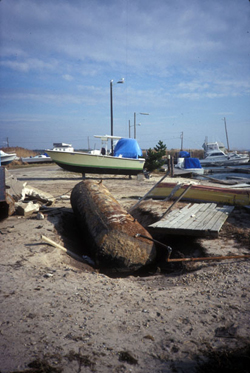New York Sea Grant's
Marina Pollution Prevention Web Site
Section 4: Fueling
- Fuel
Tank Disposal
Potential Environmental Impacts
According to the EPA, the complex hydrocarbon compounds  in
petroleum products are toxic to marine life, upset fish reproduction
and interfere with growth and reproduction of bottom dwelling
organisms. Improperly disposed fuel tanks can also impact groundwater
supplies and pose a serious fire safety risk.
in
petroleum products are toxic to marine life, upset fish reproduction
and interfere with growth and reproduction of bottom dwelling
organisms. Improperly disposed fuel tanks can also impact groundwater
supplies and pose a serious fire safety risk.
Best Management
Practices
Use, recondition
or recycle all usable fuel before disposing of the tank.
Store
tanks awaiting disposal away from ignition sources like heat or
sparks.
Clearly label
tanks "Waste Gasoline."
Regulatory
Issues
If a portable
or fixed tank for gasoline or an oil and gasoline mixture is empty,
meaning drained of all material that can be removed from the container
by normal methods like pouring or pumping, AND no more than one
inch (or 3% by weight) of residue remains in the container, it
can be disposed of as regular solid waste or can be recycled as
scrap metal [40 CFR 261.7, click
here]. If a tank is not empty, it must be disposed
of as hazardous waste [40 CFR 262.11, click
here].
Prior to closing
underground storage tanks (UST) through removal or in place abandonment,
you must notify your state environmental agency (in New York,
the NYSDEC), usually within 30 days. You can either remove USTs
and dispose of them as scrap metal, or you can remove the product
and fill the tank with inert solid material, such as sand or concrete
slurry, and leave it in place following the provisions specified
in the National Fire Protection Association Code 30. Representative
soil sampling of the site is also required. While specific state
requirements may vary, this usually includes sampling each of
the four sidewalls and the bottom of the tank excavation along
the centerline of the excavated UST. Samples need to be taken
from soils below the level of the bottom of the UST. Owners and/or
operators must maintain records of the sample results. For more
information on UST closure in New York, click
here.
If there is
a stormwater discharge from your facility you may have to register
for a General Permit for the Discharge of Storm Water Associated
with Industrial Activity ("Storm Water General Permit").
For more information on storm water permitting in New York,
click
here.

